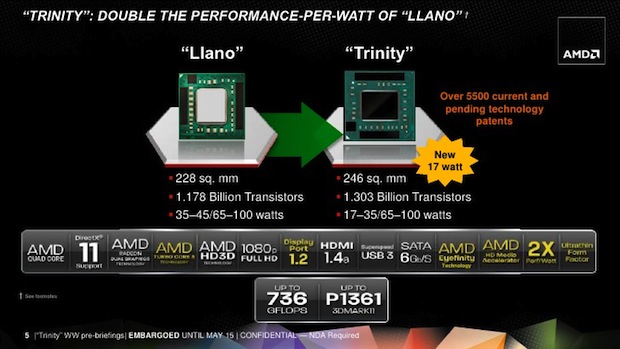AMD unveils 'Trinity' A-Series APUs

AMD unveiled on Tuesday the first crop of second-generation A-Series Accelerated Processing Units (APUs), codenamed "Trinity", which the company hopes will put pressure on Intel's recently released Ivy Bridge silicon.
The parts announced today are all mobile processors. AMD said desktop versions would follow later.

As is now the trend for processors, these parts combine the CPU and a GPU onto a single die. But unlike Intel's Ivy Bridge parts, these processors are manufactured using the older 32-nanometer process, as opposed to Intel's smaller 22-nanometer process.
While AMD has managed to squeeze more transistors into these new chips, the die size has increased compared to the earlier-generation parts.
While consumers are unperturbed by processor die size, hardware makers are. A greater size requires tablet and smartphone manufacturers to devote more space inside mobile devices to the processor.
Two low-voltage parts have been announced today. The A6-4455M is a 17W TDP dual-core processor clocked at 2.1GHz -- but can be turbo boosted up to 2.6GHz -- and features 2MB of L2 cache. The GPU is the HD 7500G and has 256 cores clocked 424MHz.
The A10-4655M is a 25W TDP quad-core processor clocked at 2.0GHz -- but with turbo boost it can go to 2.8GHz-- and features 4MB of cache. The GPU is the HD 7620G and has 384 cores running at 497MHz.
Three 35W TDP parts were also announced, starting with the A6-4400M. This is a dual-core processor clocked at 2.7GHz -- turbo boost to 3.2GHz -- and features 1MB L2 cache. The GPU is an HD 7520G and has 192 graphics cores clocked at 686MHz.
Also announced was the A8-4500M, which is a quad-core processor clocked at 1.9GHz -- turbo boost to 2.8GHz -- and has 4MB of L2 and an HD 7640G GPU with 256 cores clocked at up to 655MHz.
The most powerful part announced today is the A10-4800M. This is another quad-core processor, clocked at 2.3GHz -- turbo boost to 3.2GHz -- and features an HD 7660G GPU with 384 cores clocked at 686MHz.
According to AMD, there parts offer double the performance-per-Watt of the previous generation hardware.
On paper, these APUs seem to have two advantages over Intel's recently released Ivy Bridge parts. First, they are lower-power parts, which means that portable systems will enjoy greater battery life. Secondly, and perhaps more sore significantly, the HD 7000 series GPU appears to be far superior to the GPU found in equivalent Ivy Bridge processors.
We will have to wait for independent benchmark testing of hardware to confirm these observations.
Better GPU performance could be AMD's ace up its sleeve, especially as OEMs are making increased use of high-resolution displays on systems such as ultrathin devices, which, because if their size, are not able to benefit from discrete graphics.
Image credit: AMD.
Related:
- CNET UK: AMD A Series 'Trinity' processors: what you need to know
- ZDNet:AMD's 'Trinity' challenge to Intel's Ivy Bridge: Will the OEMs be convinced?
- Intel wants to be inside the iPad
- Intel announces Ivy Bridge chips for high-end laptops and desktops
- Intel’s Ivy Bridge: Aggressive launch, but a lot of wild cards
- Why Intel’s 22nm technology really matters